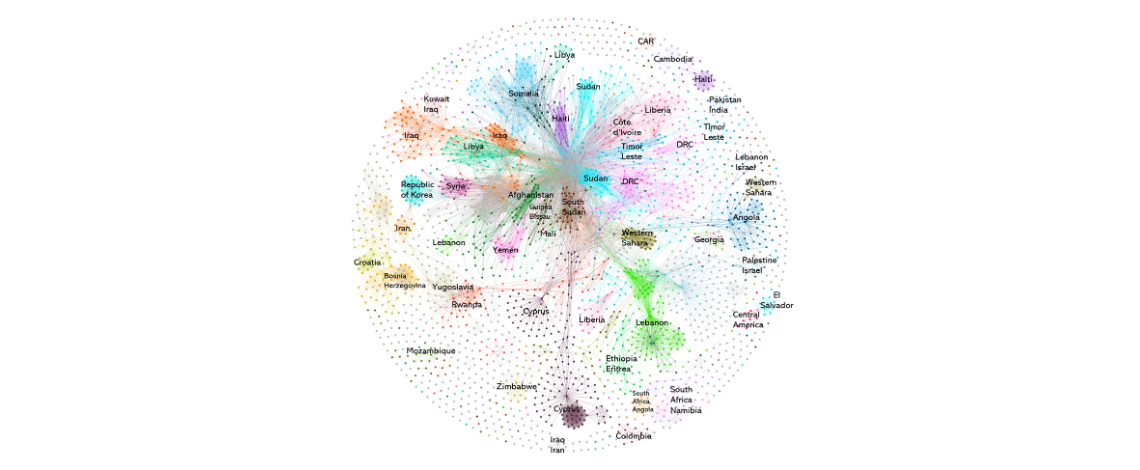Computational Diplomacy at the SiDLab

In recent years, the connection between science and diplomacy has gained prominence. Terms such as ‘science diplomacy,’ ‘diplomacy for science,’ ‘science for diplomacy,’ and ‘science in diplomacy’ frequently appear in various media. Science diplomacy, or ‘science for diplomacy,’ emphasizes that science acts as a form of soft power, fostering collaboration and building bridges between nations through shared scientific endeavors. Institutions like CERN or ITER exemplify this approach. In contrast, ‘diplomacy for science’ takes the opposite approach: it involves negotiations and diplomatic actions to support international collaborations, shared infrastructures, and joint research programs. As for ‘science in diplomacy,’ it refers to applying scientific methods to assist diplomatic efforts, providing tools and data to help decision-makers. The SiDLab—jointly established between UNIGE and ETH Zürich—and our ‘computational diplomacy’ initiative are aligned with the goals and ambitions of science in diplomacy. At the SiDLab, we believe that experts across fields—computer scientists, physicists, mathematicians, social scientists, and international relations researchers—are now well-equipped to form an interdisciplinary research team to tackle the challenge of using quantitative tools and approaches to explore and uncover the mechanisms at play in our complex global system of international relations. The SiDLab is particularly interested in the dynamics of multilateral diplomacy and cooperation in a multipolar world.
While modern diplomacy in our globalized, interconnected world has adopted technological tools such as encrypted communication, digital propaganda, intelligence gathering, and sentiment analysis, it has remained conservative in embracing computational approaches. Yet, diplomacy today involves navigating the intersecting interests of a diverse and growing array of stakeholders—from states and regional alliances to corporations, interest groups, think tanks, and civil society. The increasing complexity of diplomatic negotiations, which now occur through a dense and dynamic network of formal and informal channels, could greatly benefit from applying rigorous scientific methods such as computational diplomacy.
Computational diplomacy presents an unprecedented means to describe, analyze, and understand a wide array of emerging challenges, thus creating new scientific opportunities. While mathematics is often referred to as the 'grammar of the sciences,' modern computational methods extend this role, pushing the boundaries from natural sciences into the social sciences. However, understanding the world does not always require solving equations. Models that implement rule-based behaviors—based on a series of actions and reactions—often align more closely with our intuitive perception of how the universe operates than complex equation-solving processes. Computational diplomacy, therefore, uses a new language for describing the world and our societies. This language is rooted in what is commonly called ‘computational thinking,’ which seeks to represent phenomena as computational processes among the core entities of a system. Numerical modeling and simulations exemplify computational thinking and are particularly well-suited for studying complex systems that pervade our natural and social environments.
Modern data science, machine learning, and artificial intelligence provide additional tools for analysis. These technologies allow us to massage data to infer rules, uncover patterns, and detect hidden regularities, significantly enhancing our understanding of processes that are not strictly governed by the fundamental laws of physics. As a result, computational diplomacy and similar approaches in computational social science offer a promising methodology to complement the current traditional approaches employed in the social sciences.
The aim is to establish ‘computational diplomacy’ as a new, open, and promising field of research. This nascent discipline applies modern computer science tools and techniques to gather and organize data in the field of international relations, particularly multilateral processes. Indeed, our societies’ climate and health challenges have exposed the weaknesses of current multilateralism, especially when seeking solutions to global crises. The climate crisis, unfortunately, epitomizes this. Scientists from all disciplines have contributed to understanding its origin, forecasting its impact, and mitigating its consequences. However, tackling the full spectrum of the climate crisis requires a global-level strategic and collaborative response, which can only be achieved through effective multilateral diplomacy, which is currently lacking. The SiDLab research team aims to extract valuable insights from this data and provide high-quality information to researchers, diplomats, and negotiators.
The multilateral ecosystem, encompassing organizations like the UN, WHO, and many others based in Geneva, has generated troves of data since its emergence in 1945. Computational diplomacy can play a crucial role in identifying processes and patterns unique to this complex multilateral ecosystem by collecting and organizing these existing datasets. Such insights could lead to a significant reevaluation of how we understand and ultimately foster multilateral cooperation. As an example, the figure below shows a representation of the network of citations of resolutions adopted by the UN Security Council from 1946 to 2023. Each resolution is a node, and each edge corresponds to a quotation from one resolution to another (resolutions are colored according to the toponym in their title). In an increasingly digital world, combining diplomacy with computer science may not be as far-fetched as it seems. By advancing computational diplomacy as the science of an art, the SiDLab seeks to help establish the foundations for a more prosperous yet sustainable global order.

Figure: network of citations of resolutions adopted by the UN Security Council from 1946 to 2023. Each resolution is a node, and each edge corresponds to a quotation from one resolution to another (resolutions are colored according to the toponym in their title)
Roland Bouffanais, Didier Wernli, Jean-Luc Falcone, Nicolas Levrat, Bastien Chopard
SHARE THIS ARTICLE:
